Thousands rally in Basque town Altsasu to demand the freedom of the seven arrested youths
“We want justice, free the detainees” was 20,000 people's demand in Altsasu. The deafening silence was only broken by the sound of applause. The seven young people who were arrested as a result of the fight on the 15th of October have spent more than two weeks in Soto de la Real and Alcalá de Henares prisons, near Madrid, 400 kilometres from their homes in the Sakana valley. They are accused of crimes which could be punished with between ten and fifteen years in prison. We are going to try to put this in context.

As the result of a fight between two Spanish Civil Guards and their couples – dressed in civilian clothes – and a group of people from Altsasu which took place at 05:00 AM of 15th October, during the town festivities, one of the policemen ended up with an injured ankle and seven young people were arrested: Iñaki Abad, Oihan Arranz, Jon Ander Cob, Julen Goikoetxea, Jokin Unamuno, Aratz Urruzola and Adur Ramirez. They are each in danger of facing between ten and fifteen years in prison.
What happened? There are contradictory versions
On the 15th of October, most of the major Spanish media reported that the Civil Guards and their couples had been "attacked", "ambushed" or "lynched" by 50 people. The people from Altsasu, at the press conference they gave on the following day, denied that, saying that "the policemen had provoked the fight in a bar". One of the Civil Guards' couples declared to the Navarrese police that evening that there had been six "attackers". That same evening, two people were arrested in Altsasu and the Navarrese police charged against the people who had gathered outside the Spanish Civil Guard barracks to demand their freedom.
The news caused a scandal, and the following day the Spanish prime minister, Mariano Rajoy, made declarations offering the Civil Guard his "entire support". "There will be no impunity", he said. Amongst political parties, Sortu was the only one to give the detainees its full support from the first moment. At first, the Government of Navarre condemned the attack, stating its support for the Civil Guard and sending a representative to the demonstration held on 18th October in Pamplona. Later on, Geroa Bai and the Navarrese branch of Podemos condemned the arrests, the latter in spite of the party in Madrid saying the opposite, agreeing with the Civil Guard's official version.
During that first weekend, 2,000 people gathered behind the slogan "No police sham, leave Altsasu alone". Most of the Spanish media, however, made the story about the messages of support for the Civil Guard sent by four members of the ETA victims' association Covite.
Erdian sartu da patrol bat, baina laster alde egin du. "Ni se os quiere, ni se os necesita" oihuak #Altsasu pic.twitter.com/tbivhATICU
— Aitor Agirrezabal (@aagirrezabal) 2016(e)ko urriak 22
"A patrol of the Spanish Civil Guard went through the demonstration. Shouts: "We don't want you, we don't need you".
Prison for between ten and fifteen years?
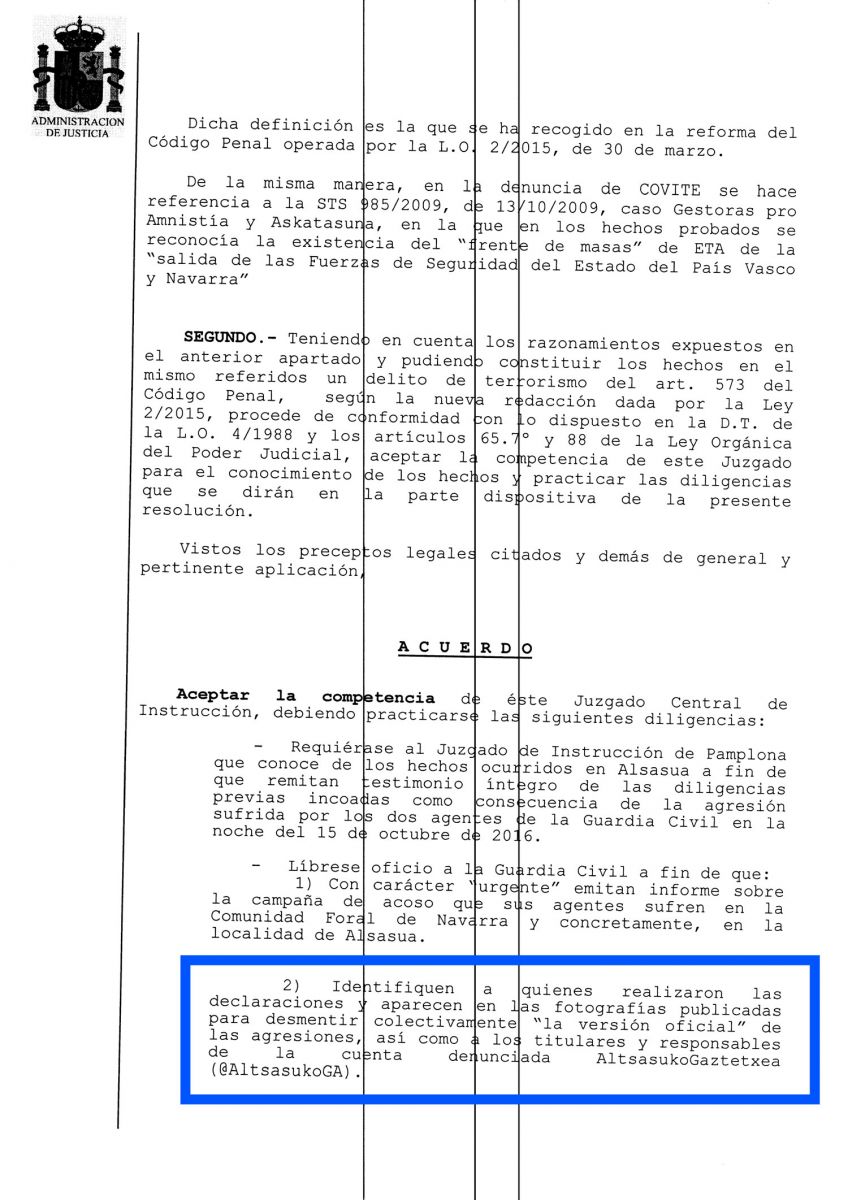
Matters have grown exponentially, and they are going to be tried for "terrorism". Covite, the Spanish National Court, most of the major Spanish media and unionist political parties are in favour of the young people being tried for "terrorism". At first, the Spanish Civil Guard's own report stated that they did not consider it to be a "terrorist act", the Spanish police seeing it as a "hate crime". The Navarrese police did not see it as an act of terrorism either. It was only later that the Spanish Civil Guard began to see it as terrorism. Finally, instead of holding the trial in Iruñea, it has been sent to the Spanish National Court to be tried following that criteria.
The National Court set its sights on the people of Altsasu who questioned the official version. The judge ordered the identification of the citizens who had stated opinions against the two arrests and contrary to the official version which was being given by the media, and of the people who were managing the Altsasu young people's Twitter account.
The judge ordered the police to investigate twelve young people, seven of them being eventually charged.
There was a fight on the Monday morning after the demonstration, 7th November, when threatening ultra-right wing Falange graffiti appeared outside the bar. The same day, the massive presence in the town of policemen dressed in civilian clothes was denounced. On 8th November, "a serious, insufferable situation of pressure" was denounced after some townspeople clashed with policemen dressed in civilian clothes.
In the same context, on 8th November, several victims spoke at the Navarrese parliament. Amongst others, Oihan Unai Ataun spoke about his experience. He denounced being tortured and no judge having investigated the issue. Finally, the Strasbourg court imposed a punishment on the Spanish state.
#Hitzorduak @txoihan, torturado por la Guardia Civil. Su denuncia no fue investigada y por ello el estado fue condenado x Estrasburgo. pic.twitter.com/vS0MboU902
— Ahotsa.info (@AhotsaInfo) 2016(e)ko azaroak 8
Arrests on Monday morning
Several of the young people who were on the police list presented themselves at Iruñea court. However, they were not held there. On 14th November, eight young people were arrested, many of them on their way to work or class. They were taken to Madrid and, by that night, six of them had been imprisoned due to what judge Carmen Lamela called "the clear risk of them fleeing the country". She accused them of "creating an atmosphere of fear" in the town. On Wednesday afternoon a seventh young person was arrested – Adur Ramirez – and one person was released.
The reasons for locking Iñaki Abad up were peculiar: "having looked directly" at the Spanish Civil Guards and their couples "in a scornful manner". Some people have pointed out that until now nobody had been imprisoned in Spain for such a thing.
The judge justified the arrests with other arguments. For instance, at the press conference, the “Alde hemendik!” ('Get Out of Here!') poster had included "ETA's usual logo, the bent two-headed arrow". The two-headed arrow is one of the Alde Hemendik campaign's logos and, beyond ETA, all sorts of groups in the Basque Country which demand the same thing have used it.
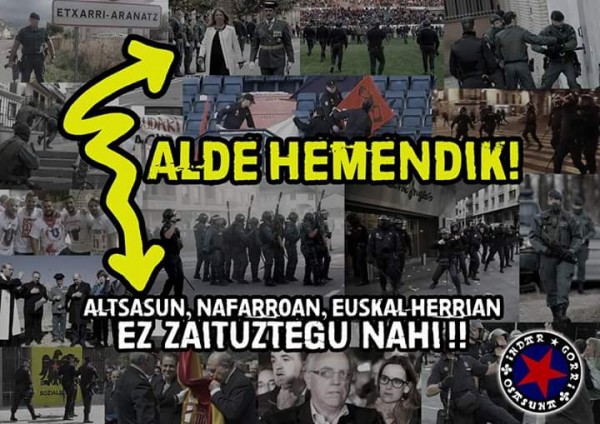
As historian Iñaki Egaña pointed out, EIA, which formed the Euskadiko Ezkerra coalition, later joining PSE-EE, was the first to use the “Que Se Vayan” ('Get Out of Here!', in Spanish) slogan.
Gara newspaper, quoting Altsasu sources, reported that they were a heterogeneous group, that the nine people who have been arrested are committed members of social movements. They are not members of violent groups, although that is the impression which the Spanish National Court gives. What they have in common is that they have often gone to the youth centre, helped organise local events and taken part in them.
Sights set on calls for demilitarisation
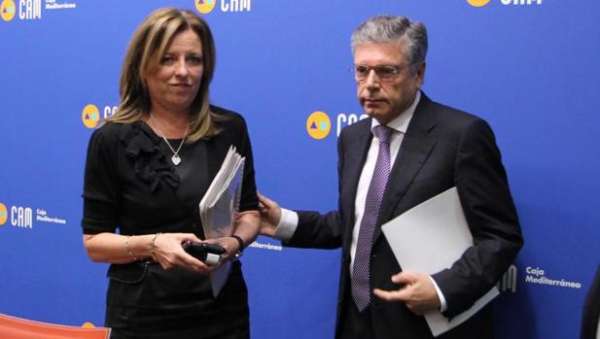
Judge Carmen Lamela has taken advantage of the events in the bar to arrest members of the Ospa movement ("Get Out of Here!"). Many Basque citizens take part in movements such as Alde Hemendik and Fan Hemendik, demanding that the Spanish police forces leave the Basque Country. Initiatives in Oñati over the last twenty years have become well-known, for instance the human chain around the Civil Guard barracks in 2015.
The citizens of Sakana valley, has been one of the main promoters of this deman, and it is remembered in this article at Borroka Garaia Da. In 2001, for instance, 15 town referenda were organised about "The appropriateness of the Civil Guard's presence", although finally the High Court of Navarre forbade them and they were not held.
"Ospa Eguna" ('Get Out Day') has been the main force behind the demand over the last five years. A day-long festive event is held in the town. It has been polemical and tense over recent years because, in 2014, hundreds of people burned the Civil Guard's symbol, a giant three-cornered hat in the town square. The following year, the Spanish Civil Guard forced its way in to the town square and removed several floats which made some reference to the Civil Guard and the Spanish military.
Following the recent arrests, many article attacking Ospa have been published in the most retrograde Spanish press.
"I thought I'd seen everything"
Detainee's lawyer Amaia Izko described what has happened in the following words: "I thought I'd seen everything in the Spanish National Court, but I'd never seen this legal farce. There is no basis to the trial".
The Government of Navarre's interior minister, José Beaumont, has denounced the arrests. "There was no need to make these arrests, and less so in the morning". Prime Minister Uxue Barkos confirmed that the arrests had been unnecessary. In the Navarrese branch of Podemos' opinion, classifying the events as "terrorism" is "serious", and EH Bildu has asked for the detainees to be released. UPN spokesman Javier Esparza has praised the Civil Guard's work and denounced the "cowardly attack".
The Basque Country is the area of the EU with the greatest density of police per inhabitant
The arrests are causing grief and considerable anger in Altsasu and in many parts of Basque society. Many of the people of Altsasu feel that all the 7,600 townspeople are being treated as criminals.
After members of the Basque left, many representatives of the Navarrese branch of Podemos and of EAJ (Basque right) have now spoken out. Several members of the Spanish socialist party have also expressed their opposition (including town councillors in Altsasu), although the Navarrese branch of the Spanish socialist party (and, of course, the central office) have taken the official line from the start. To give two examples, the words of Blanca Urgel, former head of department in Patxi Lopez's government (Spanish socialist): "I don't know what has happened in Altsasu, but I do know one thing: Spain's gone mad, and I can't see a cure for it anywhere". Judge Baltasar Garzon says that it should not be tried as terrorism. "That seems too much to me. It seems that some people don't want this to end, and that's very dangerous".
Is it possible to be accused of a crime of terrorism without any terrorist organisation?
The basis for it is in the reform of the Criminal Code which PP (Spanish right) and PSOE (Spanish socialist) passed in 2015. “The Spanish state is going to have the severest Civil Code in Western culture” is what Madrid lawyer Endika Zulueta said at the time in Rebelion. The definition of terrorism was made looser and then dangerously broadened. "If you seriously disturb the peace, you're a terrorist".
Spanish National Court judge Carmen Lamela has used that definition for the fight in Altsasu. However, many criminal lawyers do not agree with that. Many articles published in El País newspaper, for instance, included quotes from the professor of Penal Law at Barcelona Autonomous University, Joan Queral. “It should be brought to trial in a different way (...) This article, 573 in the Criminal Code, should be applied using common sense in a democratic society".
Too much police in Sakana valley
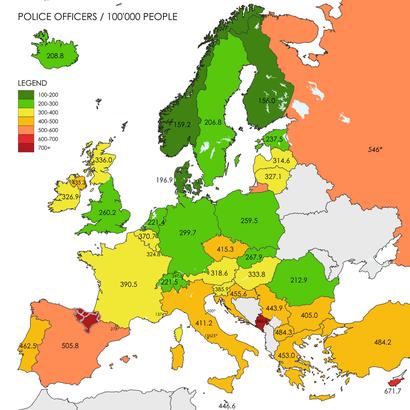 According to data provided by the Basque Government's interior department, the French and Spanish interior ministries and Eurostat research centre, the Basque Country is the area of the EU with the greatest density of police per inhabitant. There are more than six police officials for every thousand inhabitants, which is far from the EU's recommendation of two officials for every thousand inhabitants. Nor should it be forgotten that, until compulsory military service was abolished in the 1980's, Navarre was the "world capital" in the civil movement against military service, army and militarism, as Sabino Cuadra reminds.
According to data provided by the Basque Government's interior department, the French and Spanish interior ministries and Eurostat research centre, the Basque Country is the area of the EU with the greatest density of police per inhabitant. There are more than six police officials for every thousand inhabitants, which is far from the EU's recommendation of two officials for every thousand inhabitants. Nor should it be forgotten that, until compulsory military service was abolished in the 1980's, Navarre was the "world capital" in the civil movement against military service, army and militarism, as Sabino Cuadra reminds.
The Civil Guard has 40 barracks in the southern Basque Country to which – to complete the picture – the Spanish National Police must be added, as well as the Spanish armed forces, the Basque police and the Navarrese police. There are French police and Gendarmerie barracks in the northern Basque Country.
There are three barracks in Sakana valley: one Navarrese police barracks and two Civil Guard barracks, one of which is in Altsasu. During the first nine months of 2016, 450 controls were carried out on the roads into the town, and the townspeople have denounced abuse of power taking place during many of them.
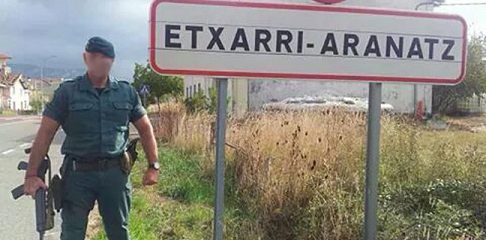
In one report given to the Basque Criminology Institute by the Basque Government, there are witness accounts of 4,000 cases of torture and maltreatment suffered by citizens between 1960 and 2013. The Civil Guard is at the top of that list of witness accounts of torture. During recent days on the Internet, many people have reminded us about the Civil Guard's violations of civil rights.
Preliminary Report identifies +4000 torture cases to Basque militants (much more to come acording to experts) https://t.co/pDeg6LhV26
— urko aiartza (@uaiartza) 2016(e)ko ekainak 27
Altsasu town council has also denounced the Spanish Civil Guard's "excessive pressure" on the town. PNV's (Basque Nationalist Party) Unai Hualde's words are highly significant: "During the festivities weekend the Civil Guard 'took' Altsasu as if it were the Gaza Strip".
With the issue red hot, on 17th November the Spanish army walked around the streets of Leitza, as can be seen in photos and on videos.
Attack on Ahotsa.info
Following declarations from the unionist, right-wing party UPN, El Mundo newspaper and Antena3 tv published and broadcast information attacking Ahotsa.info local media. Ahotsa is the first media to denounce the Spanish 'Gag Law' at the Strasbourg Civil Rights Court, amongst other things. Since the events in Altsasu, it has published information which questions the official version.
“The Government of Navarre subsidises a website which attacks the Civil Guard” was what journalist Fernando Lazaro wrote on the cover of El Mundo. Ahotsa journalist Miguel Angel Llamas said of Info7 radio that “They want to close Ahotsa.info down". On the web #GureAhotsa hash tag became a Trending Topic throughout the Spanish state, reaching many other people over the Internet. At the weekend, many political representatives and local movements made a video in Iruñea.
Solidarity demonstrations in the Basque Country
Over recent days many protests against the Altsasu arrests and calling for the release of the detainees have been held in the Basque Country. EH Bildu's Marian Beitialarrangoitia has stated that there is a wish to criminalise political debate about demilitarisation behind the legal process.
Bilbon musikarekin ere esaten diogu: @AldeHemendik @SortuBilbo pic.twitter.com/YHOzn9Jk67
— Karlos Renedo (@otxargorri) 2016(e)ko azaroak 18
Many initiatives have taken place in many Basque towns and cities: In front of the Gasteiz Judimendi military government office and the Sansomendi Civil Guard barracks, Erromo, Arrasate, Donostia, Iruñea, Tolosa, Azpeitia, Deustu, Erandio and Santurtzi; there have been demonstrations in Bilbao, Beasain and at Leioa university. People from all over the Basque Country came together in Altsasu on Saturday, expressing their solidarity and calling for the detainees' freedom.
How will it all end? It seems a case in the Basque Country will be used as a boundary stone for the cloudy limits to the new Penal Code. As long Spanish left-wing politicians remain silent, there is a high chance that these interpretations will also be used south of the Ebro river, in the whole Spanish state.
Tough times in Altsasu
Local journalist Alberto Barandiaran described the situation this way: "I see the people of Altsasu more united than ever, in collective pain and anger. Let's see if that becomes a constructive force".
This article was translated by 11itzulpen, thank you very much.
ARGIA is a news media funded in 1919 in Pamplona and published in Basque language. At first religious – called Zeruko Argia, "light of heaven” –, forbidden during the fascist dictatorship in Spain from 1936 on, in the 1950s and 1960s it had managed to come... [+]
In this series of articles, it should now have become clear that venture capital has created a system in which two types of companies become global giants: companies with bad business models but good marketing, or good business models and horrible impacts on society. This... [+]
One of the confusing aspects of the tech industry is that from a distance all the companies can seem the same. They use apps, have similar design styles, are based in hip urban centers, and strangely have millions of dollars without making any money. In part, this series is... [+]
After publishing Glovolizacion, a three-month undercover investigation into the working conditions of Glovo riders, I received almost entirely positive feedback from the general public and riders alike. Most riders felt ignored and exploited, and most readers were interested in... [+]
This is the third in a four-part investigative series examining Glovo’s business model and its relationship with the world it operates. Based on public statements by Glovo’s founders, this article will contextualize their world-view and the changes they hope to... [+]











